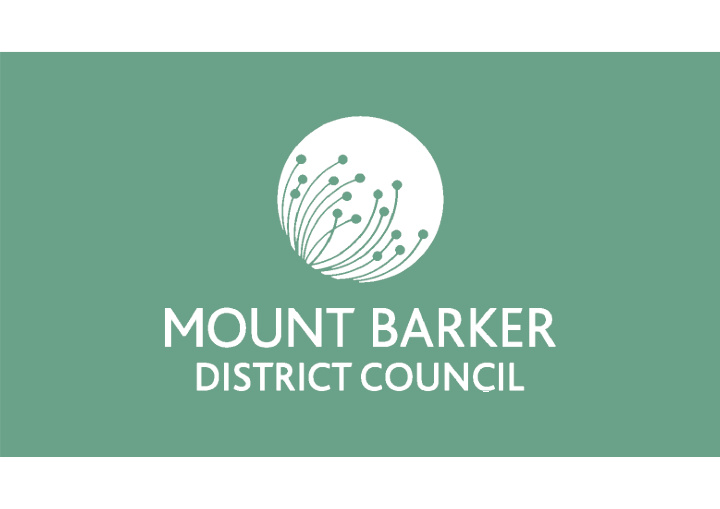



Asset Management • What is asset management? • Why do we do it? • How do we do it? • Who does it and what’s our role? • What’s the current status? • What does the future hold? • How can we improve?
What is Asset Management?
What is Asset Management? https://www.youtube.com/watch?v=Wx6YxOZkWZc
Why do Asset Management?
Why do Asset Management? • Compliance • Makes sense • Best practice • Reduces risk • Saves money • Prepares us for the future • Maintain quality of life • Customer satisfaction
Why do Asset Management? Mount Barker 2035 District Strategic Plan
Why do Asset Management? • Statutory Requirement - should be updated within 2 years of an election • Minister for Local Government “During future audit attendances, we will monitor the progress made in addressing the update to these key plans and the potential impact any changes in key assumptions or estimates may have on existing asset valuation and depreciation estimates used for financial reporting purposes.” (Dec 2017 External Auditors Management Report)
How do we do Asset Management?
Asset Management Framework • Strategic Plans and LTFP • Policy and Procedures • Asset Management Strategy • Asset Management Plans • Operational Plans – Capital works programs – Maintenance works programs • Systems and Data • People….
Asset Management Methodology • National Asset Management Framework (NAMS) • Adhere to the International Infrastructure Management Manual (IIMM) and ISO 55000 Standards • Qualified staff (Certificate in Asset Planning) • Asset Management Plan and policy templates
Asset Management Plans • Transport • Wastewater • Stormwater • Recreation and Open Space • Buildings • Plant and Fleet • ICT
Who does Asset Management?
Who does Asset Management? • Council Members – govern the implementation of the plans • Chief Executive Officer/Senior Exec – provide resources and capacity • Council inside staff – develop and review the plans • Council outside staff – implement the plans • Finance staff – identify funding for the plans • General Public – provide feedback and help set the standards/service levels WE ALL DO….
What’s the Current Status?
What do we own? How many: Buildings and Structures? 301 Kilometres of Stormwater Pipes? 142km Stormwater Pits? 5,137 Kilometres of unsealed roads 456km Bridges and Culverts 268 Playing Fields 126 Playgrounds 35 Wastewater Pump Stations? 21
What are our assets worth? Over $625million of infrastructure assets… Annual depreciation expense of approximately $8million …
What condition are our assets in?
GP7 PB6 What condition are our assets in? Chart showing what percentage of each asset category has already consumed/depreciated
Slide 22 GP7 does this mean of the WW assets 23% has depreciated? Greg Parker, 4/05/2018 PB6 Yes. The WDV is 77% of the total replacement cost. Across all assets - pumps, pipes, treatment plant Phil Burton, 4/05/2018
What levels of service do we provide? • We manage and maintain our assets to deliver services to our community. • We manage expectations and develop performance measures around these services. • Two types of service levels: Customer levels of service Technical levels of service
What does it cost to provide these services? • Operations : regular activities to provide services such as public health, safety and amenity • Maintenance : regular ongoing work to keep assets operating at required service levels, including repairs when portions of an asset fail • Renewal/replacement : major work to restore, rehabilitate, replace or renew an existing asset to its required service level; no change to capacity. • Upgrades/new works : works that create a new asset for providing services, or that improves (and substantially changes) an existing asset to have greater capacity to provide services.
What does it cost to provide these services?
GP9 PB8 What does it cost to provide these services? KEY FINDING Importantly, there is little divergence between the adopted ten ‐ year budgets and predicted expenditure needs for our current assets. This indicates that our ten ‐ year budget allocations are sufficient to maintain our existing assets at current level of service at the lowest lifecycle cost. However, future reviews of the LTFP (in coming weeks) will provide opportunities to consider finance strategies for funding identified capital upgrades and new assets (as well as the whole ‐ of ‐ life costs) to respond to arising service needs from population growth and other demands.
Slide 26 GP9 Alex and Andrew may want to provide a comment on this slide Greg Parker, 4/05/2018 PB8 OK. Spoke to Alex. Phil Burton, 4/05/2018
How can we fund these services? • Our annual budget and Long Term Financial Plan determine how much funding will be provided. • Our asset plans outline what services can be provided for those funds and if there are any risks as a result. • We pursue various methods for providing infrastructure including developer contributions, grants, separate rates, partnerships and other commercial approaches. • The sustainability of service delivery across multiple generations is critical. • We use two key indicators typically to measure this: – Asset renewal funding ratio. – Medium term budgeted expenditure/projected expenditure ratio
GP9 PB8 What does it cost to provide these services?
Slide 28 GP9 Alex and Andrew may want to provide a comment on this slide Greg Parker, 4/05/2018 PB8 OK. Spoke to Alex. Phil Burton, 4/05/2018
What does the Future Hold?
What does the future hold? Identify, measure and respond to demand. What are some of the demand drivers we can identify? • Population growth • Community expectations • Expanding township boundary, increased gifted assets. • Higher density developments, greater impervious areas. • Climate change leading to more extreme weather events • Increased volumes of wastewater and sewer • Higher recycled water quality standards
Recommend
More recommend